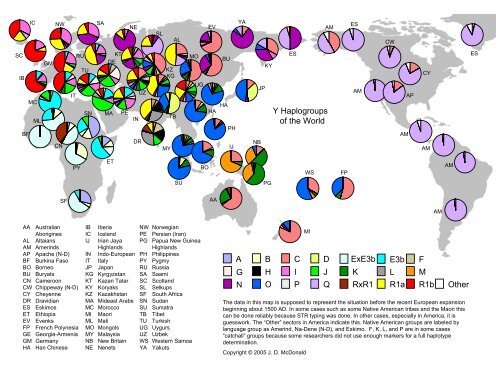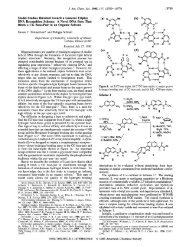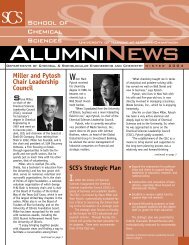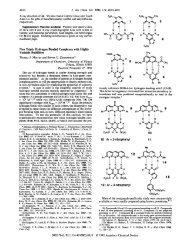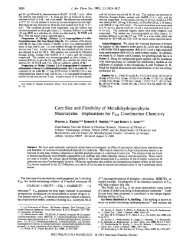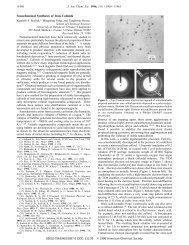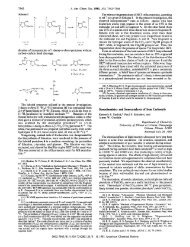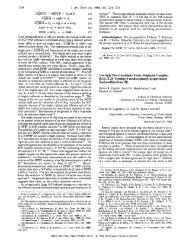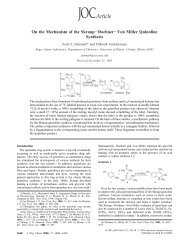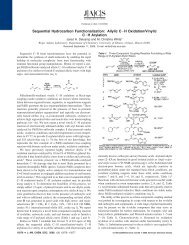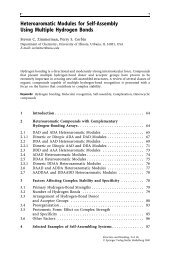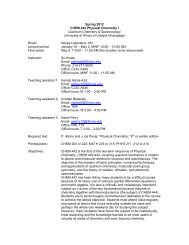Y Haplogroups of the World H O I P J Q K RxR1 E3b L R1a F M R1b ...
Y Haplogroups of the World H O I P J Q K RxR1 E3b L R1a F M R1b ...
Y Haplogroups of the World H O I P J Q K RxR1 E3b L R1a F M R1b ...
You also want an ePaper? Increase the reach of your titles
YUMPU automatically turns print PDFs into web optimized ePapers that Google loves.
SC<br />
IB<br />
BF<br />
IC NW<br />
MC<br />
ML<br />
GM<br />
CN<br />
SF<br />
IT<br />
RU<br />
PY<br />
AA Australian<br />
Aborigines<br />
AL Altaians<br />
AM Amerinds<br />
AP Apache (N-D)<br />
BF Burkina Faso<br />
BO Borneo<br />
BU Buryats<br />
CN Cameroon<br />
CW Chippeway (N-D)<br />
CY Cheyenne<br />
DR Dravidian<br />
ES Eskimos<br />
ET Ethiopia<br />
EV Evenks<br />
FP French Polynesia<br />
GE Georgia-Armenia<br />
GM Germany<br />
HA Han Chinese<br />
TU<br />
SN<br />
SA<br />
KT<br />
GE<br />
MA<br />
ET<br />
PE<br />
NE<br />
IN<br />
IB Iberia<br />
IC Iceland<br />
IJ Irian Jaya<br />
Highlands<br />
IN Indo-European<br />
IT Italy<br />
JP Japan<br />
KG Kyrgyzstan<br />
KT Kazan Tatar<br />
KY Koryaks<br />
KZ Kazakhstan<br />
MA Mideast Arabs<br />
MC Morocco<br />
MI Maori<br />
ML Mali<br />
MO Mongols<br />
MY Malaysia<br />
NB New Britain<br />
NE Nenets<br />
UZ<br />
DR<br />
SL<br />
KZ<br />
KG<br />
MY<br />
TB<br />
AL<br />
SU<br />
MO<br />
UG<br />
NW Norwegian<br />
PE Persian (Iran)<br />
PG Papua New Guinea<br />
Highlands<br />
PH Philippines<br />
PY Pygmy<br />
RU Russia<br />
SA Saami<br />
SC Scotland<br />
SL Selkups<br />
SF South Africa<br />
SN Sudan<br />
SU Sumatra<br />
TB Tibet<br />
TU Turkish<br />
UG Uygurs<br />
UZ Uzbek<br />
WS Western Samoa<br />
YA Yakuts<br />
BO<br />
EV<br />
HA<br />
AA<br />
BU<br />
HA<br />
PH<br />
IJ<br />
YA<br />
NB<br />
JP<br />
KY<br />
PG<br />
ES<br />
Y <strong>Haplogroups</strong><br />
<strong>of</strong> <strong>the</strong> <strong>World</strong><br />
AM<br />
WS FP<br />
MI<br />
The data in this map is supposed to represent <strong>the</strong> situation before <strong>the</strong> recent European expansion<br />
beginning about 1500 AD. In some cases such as some Native American tribes and <strong>the</strong> Maori this<br />
can be done reliably because STR typing was done. In o<strong>the</strong>r cases, especially in America, it is<br />
guesswork. The “O<strong>the</strong>r” sectors in America indicate this. Native American groups are labeled by<br />
language group as Amerind, Na-Dene (N-D), and Eskimo. F, K, L, and P are in some cases<br />
“catchall” groups because some researchers did not use enough markers for a full haplotype<br />
determination.<br />
Copyright © 2005 J. D. McDonald<br />
ES<br />
AM<br />
A B C D Ex<strong>E3b</strong><br />
G H I J K<br />
N O P Q <strong>RxR1</strong><br />
CW<br />
AM<br />
<strong>E3b</strong><br />
L<br />
<strong>R1a</strong><br />
AP<br />
CY<br />
AM<br />
AM<br />
AM<br />
F<br />
M<br />
<strong>R1b</strong> O<strong>the</strong>r<br />
ES
Ex<strong>E3b</strong><br />
Y <strong>Haplogroups</strong><br />
<strong>of</strong> Europe<br />
<strong>E3b</strong> F G I J K L N Q <strong>R1a</strong> <strong>R1b</strong><br />
Copyright © 2005 J. D. McDonald
A B C D E<br />
Simplified Tree <strong>of</strong> Y-Chromosome <strong>Haplogroups</strong><br />
<strong>E3b</strong> F G H I J K L M N O P Q R <strong>R1a</strong> <strong>R1b</strong>
Bibliography for Y DNA<br />
Bortolini, Maria-Catira, et. al., Y-Chromosome Evidence for Differing Ancient Demographic Histories in <strong>the</strong> Americas, Am. J. Hum. Genet.<br />
73:524–539, 2003<br />
Bosch, Elena, et. al., High level <strong>of</strong> male-biased Scandinavian admixture in Greenlandic Inuit shown by Y-chromosomal analysis, Hum. Genet.<br />
112 : 353–363, 2003<br />
Capelli, Cristian, et. al., A Predominantly Indigenous Paternal Heritage for <strong>the</strong> Austronesian-Speaking Peoples <strong>of</strong> Insular Sou<strong>the</strong>ast Asia and<br />
Oceania, Am. J. Hum. Genet. 68:432–443, 2001<br />
Cinnioglu, Cengiz, et. al., Excavating Y-chromosome haplotype strata in Anatolia, Human Genetics, 114: 127-148, 2004<br />
Cruciani, Fulvio, et. al., A Back Migration from Asia to Sub-Saharan Africa Is Supported by High-Resolution Analysis <strong>of</strong> Human Y<br />
Chromosome Haplotypes, Am. J. Hum. Genet. 70:1197–1214, 2002<br />
Faux, David, private communication<br />
Hammer, M. F., et. al., Jewish and Middle Eastern non-Jewish populations share a common pool <strong>of</strong> Y-chromosome biallelic haplotypes,<br />
Proc. Nat. Acad. Sci. USA, 97: 6769-6774, 2000<br />
Jobling, Mark A.., and Tyler-Smith, Chris, The Human Y Chromosome: An Evolutionary Marker Comes <strong>of</strong> Age, Nature Rev. Genetics,<br />
4: 598-612, 2003<br />
Karafet, T. M., et. al., Ancestral Asian Source(s) <strong>of</strong> New <strong>World</strong> Y-Chromosome Founder Haplotypes, Am. J. Hum. Genet. 64:817–831, 1999<br />
Karafet, Tatiana, et. al., Paternal Population History <strong>of</strong> East Asia: Sources, Patterns, and Microevolutionary Processes, Am. J. Hum. Genet.<br />
69:615–628, 2001<br />
Kayser, Manfred, et. al., Reduced Y-Chromosome, but Not Mitochondrial DNA, Diversity in Human Populations from West New Guinea,<br />
Am. J. Hum. Genet. 72:281–302, 2003<br />
King, Roy, and Underhill, Peter. A., Congruent distribution <strong>of</strong> Neolithic painted potter and ceramic figurines with Y-chromosome lineages,<br />
Antiquity 76: 707-714, 2002<br />
Lell, Jeffrey T., et. al., The Dual Origin and Siberian Affinities <strong>of</strong> Native American Y Chromosomes, Am. J. Hum. Genet. 70:192–206, 2002<br />
Nasidze, I., et. al., Mitochondrial DNA and Y Chromosome Variation in <strong>the</strong> Caucasus, Ann. Hum. Genetics 68:205-221, 2004<br />
Rosser, Zoë H., et. al., Y-Chromosomal Diversity in Europe Is Clinal and Influenced Primarily by Geography, Ra<strong>the</strong>r than by Language,<br />
Am. J. Hum. Genet. 67:1526–1543, 2000<br />
Tambets, Kristiina, et. al., The Western and Eastern Roots <strong>of</strong> <strong>the</strong> Saami—<strong>the</strong> Story <strong>of</strong> Genetic “Outliers” Told by Mitochondrial DNA and Y<br />
Chromosomes, Am. J. Hum. Genet. 74:661–682, 2004<br />
Underhill, Peter A., et. al., Y chromosome sequence variation and <strong>the</strong> history <strong>of</strong> human populations, Nature Genetics, 26: 358-361, 2000<br />
Underhill, Peter A. , et., al., Maori Origins, Y-Chromosome Haplotypes and Implications for Human History in <strong>the</strong> Pacific, Human Mutation<br />
17: 271-280, 2001<br />
Wells, R. Spencer, et. al., The Eurasian Heartland: A continental perspective on Y-chromosome diversity,<br />
Proc. Nat. Acad. Sci. USA, 98: 10244–10249, 2001<br />
Zegura, Stephen L., et. al., High-Resolution SNPs and Microsatellite Haplotypes Point to a Singlem Recent Entry <strong>of</strong> Native Americans<br />
Y Chrmosomes into teh Americas, Mol. Biol. Evol., 21: 164-175, 2004
PA<br />
SA<br />
TU<br />
KU<br />
PE<br />
SP<br />
KO<br />
AL Altaians KO Komi<br />
AT Aboriginal KU Kurds<br />
Taiwanese MA Mansi<br />
AU Aleuts MO Mongols<br />
AM Amerinds ND Na-Dene<br />
BU Buryats NI Nivkhs<br />
CH Chukchi PA Palestine+Egypt<br />
ES Eskimo PE Persians (Iran)<br />
EV Evenks PO Polynesians<br />
HA Han Chinese SA Saami<br />
HT Han Taiwanese SB Sabah (Borneo)<br />
HZ Hazara SP South Pakistan<br />
IN India TH Thailand<br />
IT Itelmen TU Turks<br />
JP Japanese UZ Uzbeks<br />
KE Kets YA Yakuts<br />
Copyright © 2005 J. D. McDonald<br />
MA<br />
IN<br />
KE<br />
UZ<br />
HZ<br />
TH<br />
HA<br />
HA<br />
AL<br />
L1<br />
Q<br />
F<br />
MO<br />
HA<br />
EV<br />
L2<br />
N<br />
HA<br />
HV<br />
SB<br />
BU<br />
AT<br />
HT<br />
L3<br />
I<br />
H<br />
YA<br />
NI<br />
JP<br />
M<br />
W<br />
V<br />
IT<br />
CH<br />
AU<br />
ES<br />
AM<br />
MTDNA <strong>Haplogroups</strong><br />
<strong>of</strong> <strong>the</strong> <strong>World</strong><br />
PO<br />
C<br />
A<br />
P<br />
Specific tribes or locations are shown at left. Unlabelled pies are for general population in <strong>the</strong> area.<br />
African, American, and especially Polynesian areas are very large. The data in this chart is supposed<br />
to represent <strong>the</strong> situation before <strong>the</strong> recent European expansion beginning about 1500 AD.<br />
Assignments in Australia are somewhat iffy.<br />
Z<br />
X<br />
J<br />
D<br />
Y<br />
T<br />
G<br />
R<br />
U<br />
AM<br />
E<br />
B<br />
ND<br />
ND<br />
AM<br />
AM<br />
K O<strong>the</strong>r<br />
AM<br />
AM<br />
AM<br />
AM<br />
AM<br />
ES
Simplified Tree <strong>of</strong> Mitochondrial <strong>Haplogroups</strong><br />
L1 L2 L3 M C Z D G E Q N I W A X Y R B F HV H V P J T U K<br />
Note that unlike <strong>the</strong> Y-Chromosome <strong>Haplogroups</strong>, <strong>the</strong> ones for <strong>the</strong> Mitochondrial DNA<br />
are not related in a simple way to alphabetical order. This is due to <strong>the</strong> historical nature<br />
<strong>of</strong> <strong>the</strong>ir definition. The Native American groups A, B, C, and D were put toge<strong>the</strong>r<br />
alphabetically. They are, as seen above, not closely related in <strong>the</strong> tree. M, N, and R are<br />
called “Superhaplogroups” as indicated. Note that M and N are in fact somewhat<br />
heterogeneous.
Bibliography for mtDNA<br />
Bamshad, Michael, et. al., Genetic Evidence on <strong>the</strong> Origins <strong>of</strong> Indian Caste Populations, Genome Res. 11: 994 - 1004, 2001<br />
Bermisheva, M. A, et. al., Diversity <strong>of</strong> Mitochondrial DNA <strong>Haplogroups</strong> in Ethnic Populations <strong>of</strong> <strong>the</strong> Volga-Ural Region ,<br />
Molecular Biology 36, 802-812, 2002, Translated from Molekulyarnaya Biologiya 36: 990-1001, 2002<br />
Bolnick, D. A., Unexpected Patterns <strong>of</strong> Mitochondrial DNA Variation Among Native Americans From <strong>the</strong> Sou<strong>the</strong>astern United States,<br />
Amer. J. Phys. Anth. 122: 336–354, 2003<br />
Derenko, M. V., et. al., Diversity <strong>of</strong> Mitochondrial DNA Lineages in South Siberia, Ann. Hum. Genetics 67: 391-411, 2003<br />
Fedorova, S. A., et. al., Analysis <strong>of</strong> Mitochondrial DNA Lineages in Yakuts, Molecular Biology 37: 544-553, 2003,<br />
Translated from Molekulyarnaya Biologiya 37: 643-653, 2003<br />
Forster, Peter, et. al., Phylogenetic Star Contraction Applied to Asian and Papuan mtDNA Evolution, Mol. Biol. Evol. 18: 1864–1881, 2001<br />
Friedlaender , Jonathan, et. al., Expanding Southwest Pacific Mitochondrial <strong>Haplogroups</strong> P and Q, Mol. Biol. Evol. 22: 1506–1517, 2005<br />
Helgason, Agnar, et. al., mtDNA and <strong>the</strong> Islands <strong>of</strong> <strong>the</strong> North Atlantic: Estimating <strong>the</strong> Proportions <strong>of</strong> Norse and<br />
Gaelic Ancestry, Am. J. Hum. Genet. 68: 723-737, 2001<br />
Horai, Satoshi, et. al., mtDNA Polymorphism in East Asian Populations, with Special Reference to <strong>the</strong> Peopling <strong>of</strong> Japan,<br />
Ann. Hum. Genetics 59: 579-590, 1998<br />
Kivisild, Toomas, et. al., The Place <strong>of</strong> <strong>the</strong> Indian mtDNA Variants in <strong>the</strong> Global Network <strong>of</strong> Maternal Lineages and <strong>the</strong> Peopling <strong>of</strong> <strong>the</strong> Old <strong>World</strong>,<br />
In 'Genomic Diversity', Edited by Deka, R. Papiha, S.S.Kluwer/Academic/Plenum Publishers, pp. 135-152, 1999<br />
Malhi, Ripan S., et. al., The Structure <strong>of</strong> Diversity within New <strong>World</strong> Mitochondrial DNA <strong>Haplogroups</strong>: Implications for <strong>the</strong><br />
Prehistory <strong>of</strong> North America, Am. J. Hum. Genet. 70: 905-919, 2002<br />
Malyarchuk, B. A., et. al., Mitochondrial DNA variability in Poles and Russians, Ann. Hum. Genet. 66: 261-283, 2002<br />
Metspalu, Mait, et. al. Most <strong>of</strong> <strong>the</strong> extant mtDNA boundaries in South and Southwest Asia were likely shaped during <strong>the</strong> initial<br />
settlement <strong>of</strong> Eurasia by anatomically modern humans, BMC Genetics 5: 26, 2004<br />
Oppenheimer, Stephen, et. al., Fast trains, slow boats, and <strong>the</strong> ancestry <strong>of</strong> <strong>the</strong> Polynesian islanders, Science Progress, 84: 157–181, 2002<br />
Plaza, S., et. al., Joining <strong>the</strong> Pillars <strong>of</strong> Hercules, mtDNA Sequences Show Multidirectional Gene Flow in <strong>the</strong> Western<br />
Mediterranean, Ann. Hum. Genetics 67: 312-328, 2003<br />
Quintana-Murci, Lluys, et. al., Where West Meets East: The Complex mtDNA Landscape <strong>of</strong> <strong>the</strong> Southwest and Central<br />
Asian Corridor, Am. J. Hum. Genet. 74: 827-845, 2004<br />
Richards, Martin, et. al., Report Extensive Female-Mediated Gene Flow from Sub-Saharan Africa into Near Eastern<br />
Arab Populations, Am. J. Hum. Genet. 72: 1058-1064, 2003<br />
Salas, Antonio, et. al., The Making <strong>of</strong> <strong>the</strong> African mtDNA Landscape, Am. J. Hum. Genet. 71: 1082-1111, 2002<br />
Saillard, Juliette, et. al., mtDNA Variation among Greenland Eskimos: The Edge <strong>of</strong> <strong>the</strong> Beringian Expansion,<br />
Am. J. Hum. Genet. 67: 718–726, 2000<br />
Schurr, Theodore G., Mitochondrial DNA and <strong>the</strong> Peopling <strong>of</strong> <strong>the</strong> New <strong>World</strong>, American Scientist, 88: 246-250, 2000<br />
Starikovskaya, Yelena B., et. al., mtDNA Diversity in Chukchi and Siberian Eskimos: Implications for <strong>the</strong> Genetic<br />
History <strong>of</strong> Ancient Beringia and <strong>the</strong> Peopling <strong>of</strong> <strong>the</strong> New <strong>World</strong>, Am. J. Hum. Genet. 63: 1473-1491, 1998<br />
Trejaut, Jean A., et. al., Traces <strong>of</strong> Archaic Mitochondrial Lineages Persist in Austronesian-Speaking Formosan Populations,<br />
PLOS Biology 3, 2005<br />
Yao, Yong-Gang, et. al., Phylogeographic Differentiation <strong>of</strong> Mitochondrial DNA in Han Chinese, Am. J. Hum. Genet. 70: 635-651, 2002


